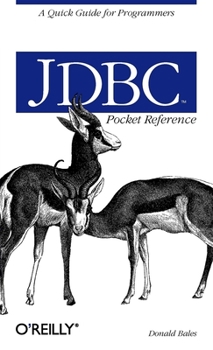JDBC Pocket Reference: A Quick Guide for Programmers
Select Format
Select Condition 
Book Overview
JDBC--the Java Database Connectivity specification--is a complex set of application programming interfaces (APIs) that developers need to understand if they want their Java applications to work with databases. JDBC is so complex that even the most experienced developers need to refresh their memories from time to time on specific methods and details. But, practically speaking, who wants to stop and thumb through a weighty tutorial volume each time...
Format:Paperback
Language:English
ISBN:0596004575
ISBN13:9780596004576
Release Date:March 2003
Publisher:O'Reilly Media
Length:151 Pages
Weight:0.35 lbs.
Dimensions:0.5" x 4.2" x 6.9"
Customer Reviews
3 ratings
A friendly and well-written book recommended for anyone ready to learn JDBC.
Published by Thriftbooks.com User , 16 years ago
A friendly and well-written book recommended for anyone ready to learn JDBC. This JDBC Pocket Reference well-written and well-organized introduction to the JDBC. It uses a careful, example-based, easy to understand approach. Contains many examples and other useful information. Thank you
Half Useful?
Published by Thriftbooks.com User , 18 years ago
The first third or so of this book consists of a nice, concise overview of JDBC, with an example for each concept. The rest is basically a printed copy of API documentation you can get online. These really are easier to read it online — the docs for DatabaseMetaData, for example, are about twenty pages long and much easier to deal with in hyperlinked format. The descriptions have been reworded (and shortened) and sometimes are a little easier to understand in the book. The book is probably enough to get you started using JDBC, especially if you have some experience using database APIs in the past (ODBC or a vendor-proprietary one). So, my recommendation is: It's half useful, so buy it used for half price. ;-)
Great Pocket Reference for JDBC
Published by Thriftbooks.com User , 21 years ago
"JDBC Pocket Reference" by Donald Bales is another great reference book from O'Reilly. Like many of O'Reilly's pocket reference books, the book has a small form factor. You can easily carry the book in your briefcase or back pocket. The book is only 145 pages long. The first 45 pages give a terse and concise explanation of how to use the JDBC API and the last 100 pages provides a quick reference to the JDBC 2.0 API. The following paragraphs provide more detail on how the book can be used by a programmer. The book is intended for programmers, but could also be applicable to ambitious database administrators (DBA) that want to create Java utilities to monitor and automate some of their DBA tasks. If you are familiar with SQL and database topics the book can provide you with a quick reference on syntax and procedures that you might forget. The book is not a tutorial on SQL, client/server programming, or relational databases. If you are not familiar with these topics or you want to learn more the JDBC Pocket Reference is not for you. The first 45 pages of the book are packed with helpful examples of how to use the JDBC API. Most JDBC programmers are familiar with these examples but often need reminders on proper syntax for different database vendors and drivers. Here are a few examples of explanations I found helpful:1. JDBC Driver types: There are four classes of JDBC drivers called type 1, 2, 3, and 4 respectively. Type 4 is the only pure 100% Java driver and is the only type described in the book, but it is helpful to understand what driver types are available.2. Database URL Syntax: Getting the proper database connection string can be frustrating since every database vendor is different. This task is usually done only once at the start of a project so it is easy to forget the correct syntax. The Pocket Reference describes 9 different database drivers giving the appropriate connection information, online references, archive file name, and supported properties for the driver. 3. Using JNDI to obtain a data source.4. Using DatabaseMetaData API to find information about the database properties and capabilities. 5. Good examples for executing standard SQL statements and retrieving the results through the ResultSet interface. 6. Store Procedures: Using the CallableStatement object to execute a stored procedure is one of the most difficult JDBC calls because stored procedures are vendor dependent. The book outlines how to set input and output parameters appropriately to make the call. I found this very helpful since a lot of the documentation from database vendors do not describe this operation very well. 7. Properly handling "null" values in JDBC. This is important because a database NULL is different than a Java null.8. Inserting and updating binary blobs is explained.9. Describes and explains how to use User-Defined Data Types (UDTs) to help you map objects to a relational database.10. Describes proper escape sequences ensur






